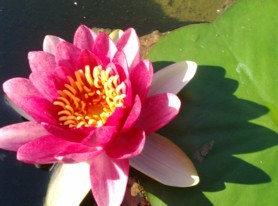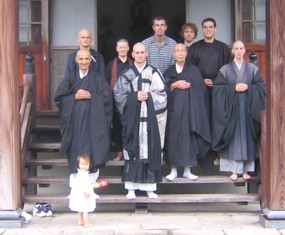|
|---|
[prev] * * * [next]
 (Adult practice - Part XVIII) |
Second question: "2. Outside of zazen practice, in our daily life when we walk, talk, eat, sit, lay down or work, should we keep being mindful of, or following anything specific? For example, like the Rinzai students who keep the koans on their minds at all times, should we be mindful of our breathing any time other than during zazen? Or when we take a regular walk, should we keep being mindful of our steps like in kinhin?" We should always try to be active coming out of samadhi. For this, we have to forget things like "I should be mindful of this or that". If you are mindful, you are already creating a separation ("I - am - mindful -of - ...."). Don't be mindful, please! When you walk, just walk. Let the walk walk. Let the talk talk (Dogen Zenji says: "When we open our mouths, it is filled with Dharma"). Let the eating eat, the sitting sit, the work work. Let sleep sleep. Kinhin is nothing special. We do not have to make our everyday life into something special. We try to live in the most natural and ordinary way possible. So my advice is: Ask yourself why you practice zazen? If it is to reach some specific goal, or to create some special state of mind, then you are heading in the opposite direction from zazen. You create a separation from reality. Please, trust zazen as it is, surrender to reality here and now, forget body and mind, and do not DO zazen, do not DO anything, don't be mindful, don't be anything - just let zazen be and follow along. To drive a car well and savely you need long practice and even then you still have to watch out very well not to cause any accident. Nobody can teach you that except the car itself, the action of driving the car itself. Take care, and stop being mindful! Third question: "Do you have any advice for stiff westerners who find sitting on the zafu difficult? I imagine you have guests from time to time who cannot sit even half lotus style. How should they practice shikantaza?" It is your own zazen practice. Nobody can help you with it. It is up to you to decide if you want to sit on a zafu, a bench, a chair, a sofa... As you know, zazen is not restricted to the zafu or the half- or full-lotus posture. You can practice zazen lying on a bed or sitting in a wheel-chair. Still, here at Antaiji I do not encourage people to make themselves too comfortable with zazen. I also do not recommend shifting the legs whenever you feel pain. That is why it is said on the web-site that you have to be prepared to die in zazen. But no one can force you to do that if you are not prepared for it. And, even though I have never heard of anyone actually dying because of the pain in the legs, zazen can be harmful to your health, especially the knees, ancles, hips and back. Damage to your health occurs when you fight the pain. The point is not to avoid the pain (by sitting comfortably or shifting your legs), but at the same time not to fight the pain either. You have to relax in the pain, allow yourself to be swallowed up by the pain, accept it with the most flexible mind. This, of course, can be extremely difficult. What ever you do, it is your practice, and you have to decide how much you are willing to sacrifice for what purpose. No one can take the responsibilty for any damage that you might do to your body and mind. I hear of ancestors who cut of their limbs for the sake of the dharma, but I can not force anyone to do the same. In Zen, we do not deny the body for the sake of the mind, but we also do not sit to promote our health. This way or that way, you will die.
(To be continued ... Docho)
|
|---|

|

Yearbook 2005 |
We will publish the "Antaiji yearbook" at the end of this year again.
The theme will be "What is the Buddha Way?" A "Zen answer" to this question would probably be to say that the Buddha Way is what lies just below your feet, right here and now. But if we do not take care, this understanding that the Buddha Way should be just below our feet, becomes mere theory. Our feet, that are supposed to walk the Buddha Way, turn out to be floating in the air! Maybe it is time for us to touch down once more and ask ourselves where we are standing, which way we are facing? This way, that Shakyamuni Buddha started to walk 2500 years ago, has since then crossed many mountain ridges. There have been turns and crossroads on what we call the "Buddha Way". Some, realizing that Buddhism today has reached a dead end, call for a "return to the source". Others feel that rather than chasing after ideals, the question is rather what we as Buddhist practioners will eat 30 years from now. Still others might say that the "Buddha Way" has nothing to do with their lifes in the first place. But you do not need to be attached to the word "Buddha Way" - what I would like to know where your way is leading. Buddha Way always means "your way". So which way are you heading right now, what is the way you are looking for? Please tell me until October 15th. Length and style of the articles are free. You can write in any language you want - if you want to reach a greater audience, write in several languages. The yearbook will be on the net towards the end of November. Looking forward to your contributions |
|---|

|

On September 28th, Seikan and Tassho became monks at Antaiji. |
|---|
